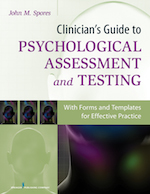Book Review—Clinician’s Guide to Psychological Assessment and Testing
 Written in a clear, concise and strategically delineated manner, The Clinician’s Guide to Psychological Assessment and Testing: With Forms and Templates for Effective Practice is written for people seeking a better understanding of various psychological tests and how those tests can inform professional practice. The author of this book, Dr. John Spores, clearly meets his stated purpose, to provide practicing clinical or counseling psychologists with a reference volume to inform their testing practice. I would note, however, that this volume can also help professionals from the fields of counseling, psychology, social work, and other related fields understand more fully how standardized psychological testing can inform their clinical work.
Written in a clear, concise and strategically delineated manner, The Clinician’s Guide to Psychological Assessment and Testing: With Forms and Templates for Effective Practice is written for people seeking a better understanding of various psychological tests and how those tests can inform professional practice. The author of this book, Dr. John Spores, clearly meets his stated purpose, to provide practicing clinical or counseling psychologists with a reference volume to inform their testing practice. I would note, however, that this volume can also help professionals from the fields of counseling, psychology, social work, and other related fields understand more fully how standardized psychological testing can inform their clinical work.
In order to do this, Dr. Spores has divided his book into three parts. The first section reviews the process of psychological assessment and standardized testing. In the introductory chapter, he makes a clear and convincing case for the use of standardized psychological testing as a way to augment and sometimes even surpass clinical interviews. Most helpful is his delineation of how the process of testing should be done and what events need to happen for the process to be done correctly. The author is also an attorney, and this comes out in the straightforward and step-wise manner in which he describes this process.
In the first section, the reader is introduced to one of the most useful aspects of this book. The author has provided numerous forms and templates for each of the processes for psychological testing. It should be noted that the author’s in-text references to the provided forms and templates are extremely helpful. For example, when the author writes about how referral sources make a referral for testing, he provides an excellent example at the end of the chapter of a “Psychological Test Referral Form.” This is consistent throughout the book. When the author references a form or report of some type, he provides an example of that form or report at the end of the chapter. This gives readers a concrete example, something they can immediately reference to understand the ideas and concepts discussed in this guide. This invaluable resource is also available in electronic format on the publisher’s Web site.
The author continues to inform the reader in section two with concrete examples of the standardized tests used in psychological testing. Divided into subsections, the section provides the reader with information about widely known and utilized tests in the following areas: (1) intelligence tests; (2) achievement tests; (3) neuropsychological tests; (4) symptom rating scales; (5) self-report clinical and personality inventories; (6) examiner-administered personality tests; and (7) adaptive behavior tests. To help clinicians even better understand the process of selecting and administering these types of tests, each subsection has four parts: a description of the construct being measured; the diagnostic reasons for conducting such a test; insurance billing and coverage issues; and examples of common tests used to measure the described construct. The author is clear that the example tests he lists are those that he likes to use for measuring a described construct, and he gives compelling reasons why he believes that they are appropriate choices.
In the final section, section three, the author provides specific case examples of children, adolescents and adults for whom standardized tests have served as a means of identifying areas of clinical concerns. These vital case examples demonstrate how the testing process can work to a clinician’s advantage in providing the best care for clients.
The only caveat to this book is that Dr. Spores assumes that the reader is trained in diagnostic interviewing, psychometrics, and administering and scoring the tests presented and discussed in this book. Accordingly, those readers who are not familiar with the common standardized tests presented in this book (e.g., Wechsler tests, Minnesota Multiphasic Personality Inventory, Rorschach) may find themselves at a disadvantage. Dr. Spores does acknowledge his assumption in the Introduction, and those readers who are not familiar with these tests may benefit from some additional reading and training before attempting to utilize this guide.
Overall, this is an excellent guide to the use and administration of psychological tests. It provides straightforward directions and instructions on how to utilize testing in such a way as to better inform clinical practice. I could see this book as a mainstay on any counselor’s bookshelf, especially those who are seeking a way to utilize standardized testing in their practice.
Spores, J. M. (2013). Clinician’s guide to psychological assessment and testing: With forms and templates for effective practice. New York, NY: Springer.
Reviewed by: Joseph P. Jordan, North Carolina Physicians Health Program and North Carolina Veterinary Health Program, Raleigh, NC.
The Professional Counselor Journal
